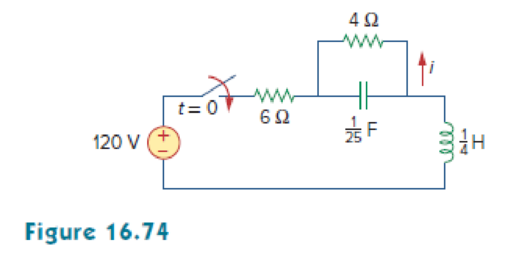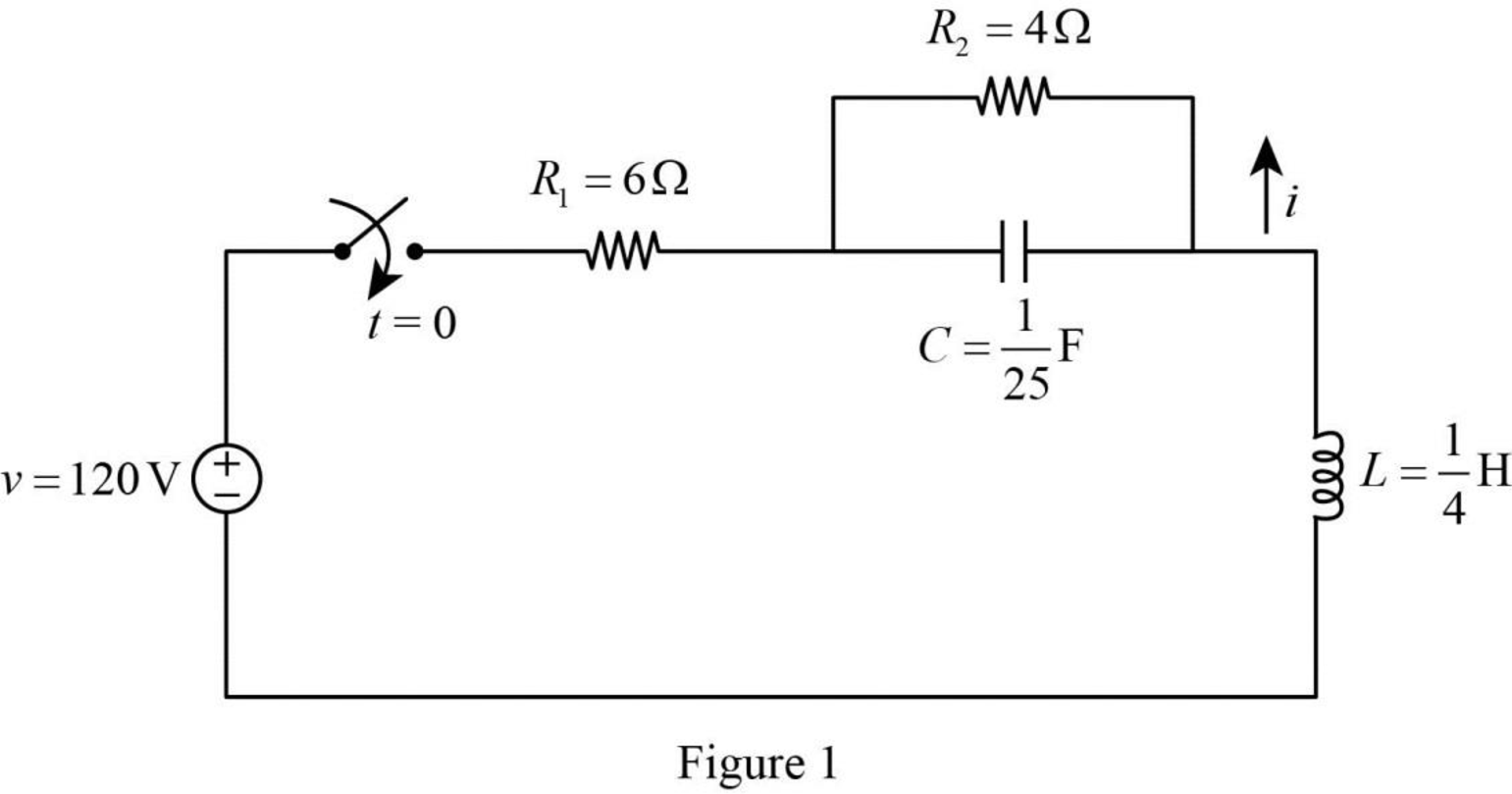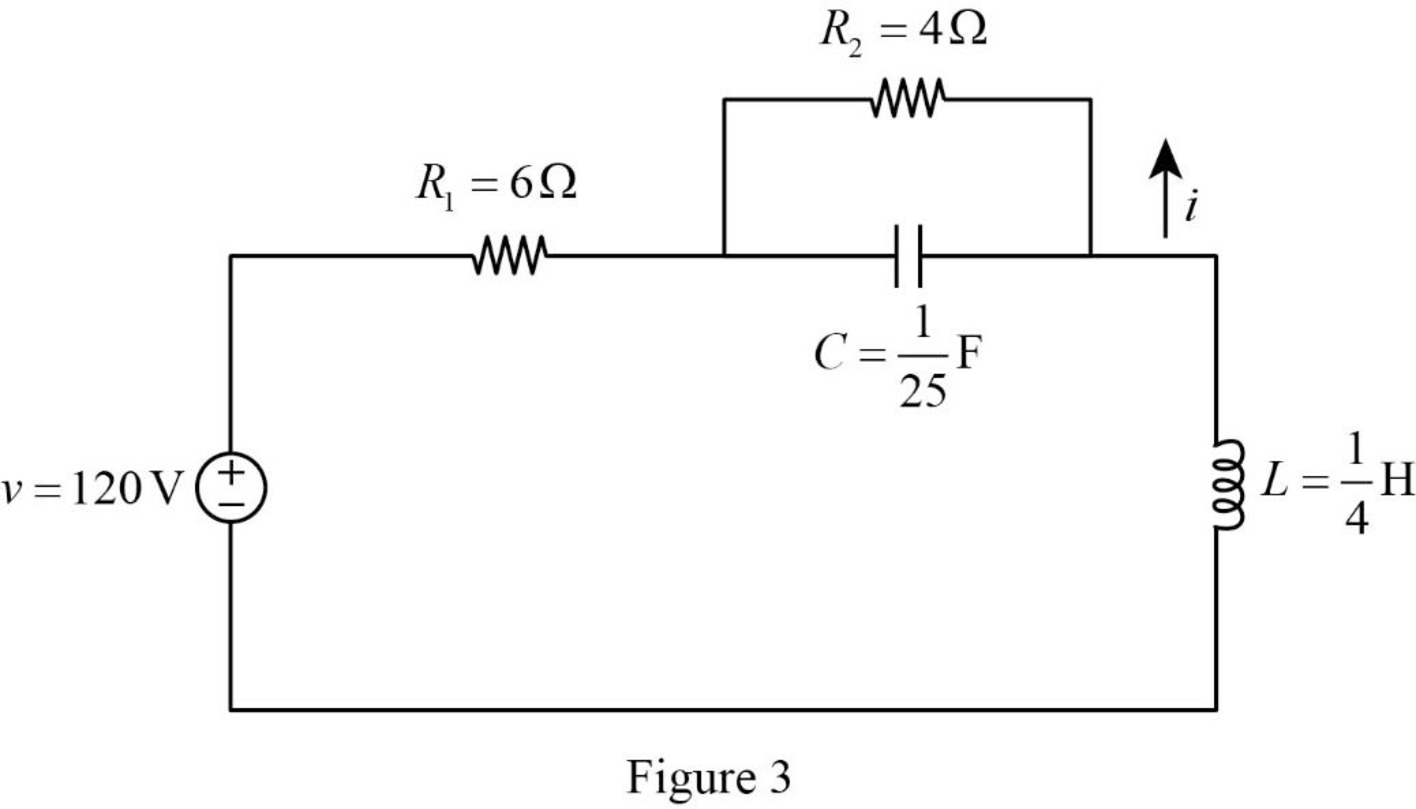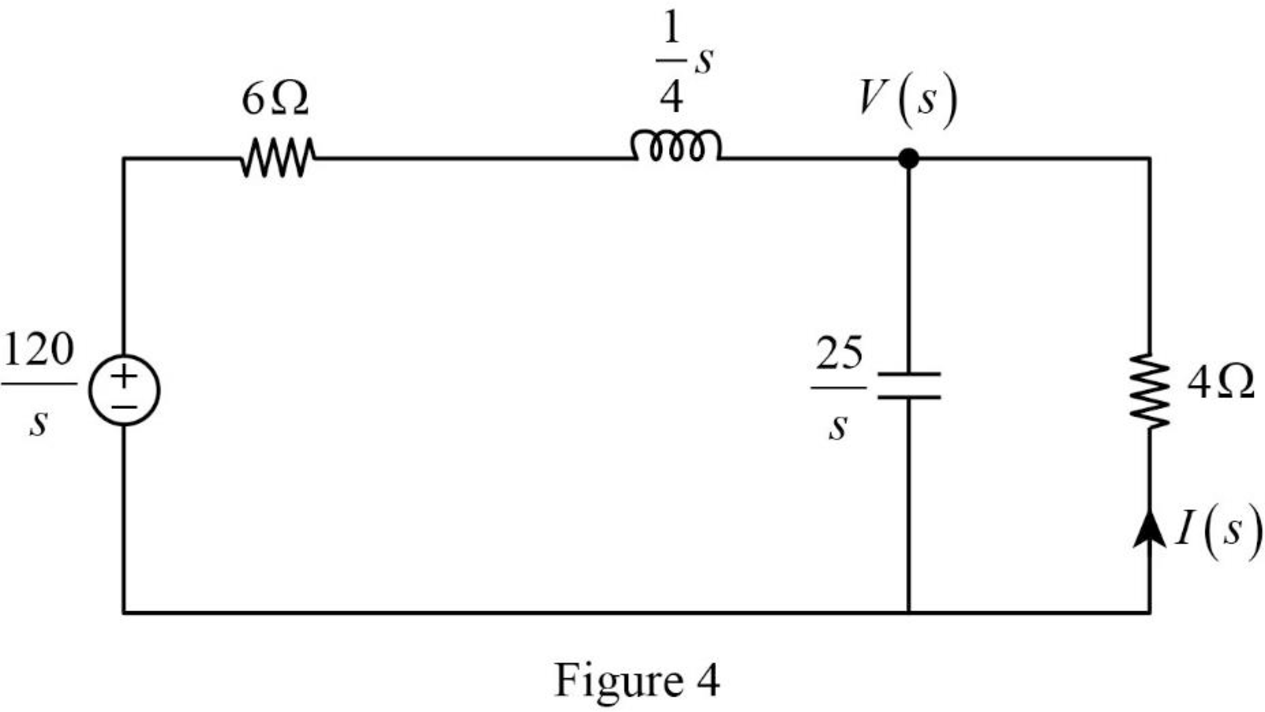
In the circuit of Fig. 16.74, find i(t) for t > 0.

Find the expression of current
Answer to Problem 51P
The expression of current
Explanation of Solution
Given data:
Refer to Figure 16.74 in the textbook.
Formula used:
Write a general expression to calculate the impedance of a resistor in s-domain.
Here,
Write a general expression to calculate the impedance of an inductor in s-domain.
Here,
Write a general expression to calculate the impedance of a capacitor in s-domain.
Here,
Calculation:
The given circuit is redrawn as shown in Figure 1.

For a DC circuit, at steady state condition when time
Now, the Figure 1 is reduced as shown in Figure 2.

Refer to Figure 2, the switch is open and there is no source connected to the circuit. Therefore, the voltage across the capacitor and current through inductor are zero.
The current through inductor and voltage across capacitor is always continuous so that,
For time

Substitute
Substitute
Substitute
Substitute
Refer to Figure 3, the circuit for
Apply Laplace transform for above to find
Convert the Figure 3 into s-domain.

Apply nodal analysis at node
Simplify the above equation as follows:
Simplify the above equation as follows:
Simplify the above equation to find
From the above equation, the characteristic equation is
Write a general expression to calculate the roots of quadratic equation
Comparing equation (5) with the equation
Substitute
Simplify the above equation to find
Substitute the roots of characteristic equation in equation (4) to find
Take partial fraction for above equation.
The equation (7) can also be written as follows:
Simplify the above equation as follows:
Substitute
Simplify the above equation as follows:
Simplify the above equation to find
Substitute
Simplify the above equation to find
Substitute
Simplify the above equation to find
Substitute
Refer to Figure 3, the current through resistor
Substitute
Take inverse Laplace transform for above equation to find
Simplify the above equation to find
Conclusion:
Thus, the expression of current
Want to see more full solutions like this?
Chapter 16 Solutions
FUNDAMENTALS OF ELEC.CIRC.(LL) >CUSTOM<
- Which of the following is the H (s) transfer function of the system whose block diagram is given? s / (4s + 3)4 s / (3s + 1)4 s / (3s + 2)s / (s + 4)4 s / (s + 1)3 s / (s + 4)arrow_forwardThe mathematical model of a system is 1y" (t) + 2y' (t) + 1y (t) = 1x' (t) + 2x (t) and the initial conditions are y(0) = 1 and y' (0) = 2. 1) Find the transfer function. 2) Find the system output when the input is Xt) = U(t).arrow_forward(Signals and Systems) Determine whether the systems with these transfer functions are stable, marginally stable or unstable by determining the poles.arrow_forward
- control systems Using the Mason Earnings Formula in the system below Ys/Rs Find the transfer functionarrow_forwardIf the transfer function V2(s) / V1(s) = s / s^2+5s+4, then find the Z. (It may contain R,L,C components). ..arrow_forwardQ/ Implement the following P.O.S function (A,B,C,D)=sum(1,5,8,9,12,13,15) using MUX's of 3*8. *arrow_forward
- convert the transfer functions into linear differential equations: a) 1/(1.896s+1) b) 130.19/((s^2)+8.22s+130.19) ..arrow_forwardUSE THE CIRCUITS IN THE S-DOMAIN, The circuit parameters in the circuit are R=500Ω,L=250mH, and C=250nF. find If Idc=5mA, find io(t)for t≥0.arrow_forwardA 400 Ω resistor, a 2.5 mH inductor, and a 40 nF capacitor are inseries. Express the s-domain impedance of this series combination as arational function.arrow_forward
- A system is described by the differential equation (see attached). a)What is the order of the system. How many poles does the system's transfer function have. How many states are needed to describe the system completely.b) Determine the system's transfer function, Y(s)/U(s) (the poles of the system are at ―1, ― 2, and ―4);c) Determine matrices A, B, C, and D to describe the system in state-space form x' = Ax + Bu, y = Cx + Du.arrow_forwardCompose differential equations and transfer functions according to the following block diagrams.arrow_forwardFind the transfer function, G(s) = X3(s) / F(s), for the translational mechanical networkarrow_forward
 Introductory Circuit Analysis (13th Edition)Electrical EngineeringISBN:9780133923605Author:Robert L. BoylestadPublisher:PEARSON
Introductory Circuit Analysis (13th Edition)Electrical EngineeringISBN:9780133923605Author:Robert L. BoylestadPublisher:PEARSON Delmar's Standard Textbook Of ElectricityElectrical EngineeringISBN:9781337900348Author:Stephen L. HermanPublisher:Cengage Learning
Delmar's Standard Textbook Of ElectricityElectrical EngineeringISBN:9781337900348Author:Stephen L. HermanPublisher:Cengage Learning Programmable Logic ControllersElectrical EngineeringISBN:9780073373843Author:Frank D. PetruzellaPublisher:McGraw-Hill Education
Programmable Logic ControllersElectrical EngineeringISBN:9780073373843Author:Frank D. PetruzellaPublisher:McGraw-Hill Education Fundamentals of Electric CircuitsElectrical EngineeringISBN:9780078028229Author:Charles K Alexander, Matthew SadikuPublisher:McGraw-Hill Education
Fundamentals of Electric CircuitsElectrical EngineeringISBN:9780078028229Author:Charles K Alexander, Matthew SadikuPublisher:McGraw-Hill Education Electric Circuits. (11th Edition)Electrical EngineeringISBN:9780134746968Author:James W. Nilsson, Susan RiedelPublisher:PEARSON
Electric Circuits. (11th Edition)Electrical EngineeringISBN:9780134746968Author:James W. Nilsson, Susan RiedelPublisher:PEARSON Engineering ElectromagneticsElectrical EngineeringISBN:9780078028151Author:Hayt, William H. (william Hart), Jr, BUCK, John A.Publisher:Mcgraw-hill Education,
Engineering ElectromagneticsElectrical EngineeringISBN:9780078028151Author:Hayt, William H. (william Hart), Jr, BUCK, John A.Publisher:Mcgraw-hill Education,





